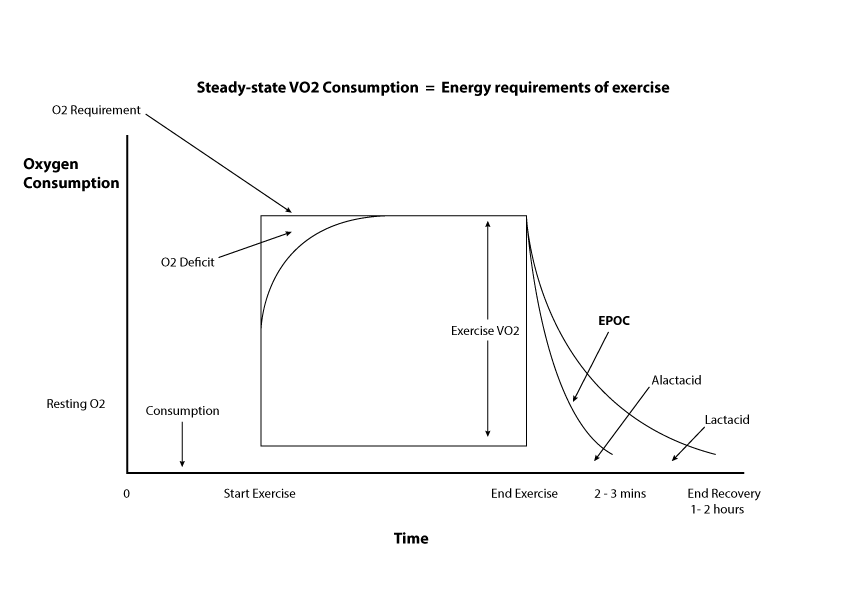Content
- Recovery process
After a strenuous exercise the athlete needs to develop an effective recovery process to; replenishment of ATP, removal of lactic acid, replenishment of myoglobin with oxygen and replenishment of glycogen. This may take 24 hours depending upon the intensity and duration of the activity undertaken
The main aim of the Recovery Process is to restore the body to its pre-exercise state. This involves the removal of by-products produced during exercise and replenish the fuels used up during exercise
Excess Post-exercise Oxygen Consumption (EPOC – formerly known as Oxygen Debt).
‘This is the excess oxygen consumption, above that at a resting level, during recovery, to restore the body to its pre-exercise state’ (which is why our Respiratory Rate remains elevated after exercise).
Below is a graph that shows EPOC with two stages of recovery:

Oxygen deficit can be thought of as the extra amount of oxygen that would be needed to complete the entire activity Aerobically
OXYGEN DEFICIT can be thought of as the extra amount of oxygen that would be needed to complete the entire activity Aerobically
| Recovery Time(seconds) | CP recovery (%) |
|---|---|
| 15 | 60 |
| 30 | 70 |
| 45 | 80 |
| 1 min | 85 |
| 2 min | 90 |
| 4 min | 97 |
By cooling down and exercising at a low intensity (jogging etc) then more oxygen is getting taken in to the muscles. This means creatine phosphate stores will replenish at a faster rate. The more oxygen that is present then the quicker the body can remove lactic acid and turn it back into energy and re-saturate the myoglobin stores
The optimum time for the body to take up carbohydrate is within 30 minutes of finishing exercise. By eating High Glycaemic Index carbohydrate (carbohydrate that release energy quickly e.g. sugary foods) and Low Glycaemic Index (Carbohydrate that release energy at a slower rate e.g. fruit, wholemeal bread, wholemeal pasta and rice) Then the body is able to begin restore the glycogen used over exercise period. (See nutrition)
The use of recovery supplements is widely used in sport for recovery purposes. They often contain a mix of carbohydrate (to re-supply the glycogen stores), protein and amino acids, (for growth and repair of the muscle) and creatine (Help restore CP stores)
The theory behind ice baths is that when we exercise at a high intensity small micro-tears occur in the muscles. Some research believes that it is these micro-tears that cause Delayed Onset of Muscle Soreness (DOMS) or at least the swelling that takes place around the micro-tears. It is believed that Ice Baths reduce the swelling around the muscle micro-tears and reduce the pain that they cause, this means that the performer is able to train at a higher level the next day. It must be noted that research on this is not conclusive.
Massage can serve two purposes; the first is psychological benefits e.g. relaxing feeling of the massage and the fact that it can be invigorating, (providing it is not a deep muscle massage).
Secondly it can help physically by returning de-oxygenated blood from the muscle tissue to the heart to be re-oxygenated.
Recent studies have concluded that compression clothing can help recovery by maximising the pumping action of the muscles in returning blood to the heart and help with subsequent removal of lactic acid and blood lactate.
There must be an understanding in the difference between alactic and lactacid oxygen debt and specifically what each system repays/removes. The candidate must also be able to provide specific examples of how the methods to speed up recovery and why each are used.
EXample 1 Cool down keeps oxygen levels elevated and therefore this means that more lactic acid can be removed (speeds up lactacid recovery) and then converted back into glucose/glycogen. Also the cool down can speed up the re-saturation of myoglobin.
Example 2 A high carbohydrate meal including protein can help restore muscle glycogen and blood glucose levels. The optimum time for uptake of glycogen into muscles is within 30mins of ceasing exercise. Protein can help repair damaged muscle tissue and help re-growth. (See nutrition/hydration section for more details of optimising recovery)
1. Explain the terms alactic and lactacid oxygen debt and describe the strategies you have used to speed up these recovery processes. (6)
2. High anaerobic capacity is essential to any team gamer player. Outline the physiological processes that will happen during a 5-minute recovery period after intense anaerobic exercise (5)
3. Cool down is an essential aspect of the recovery process. Provide an example of an appropriate cool down for your sporting activity and explain the physiological benefits to the performer. (5)